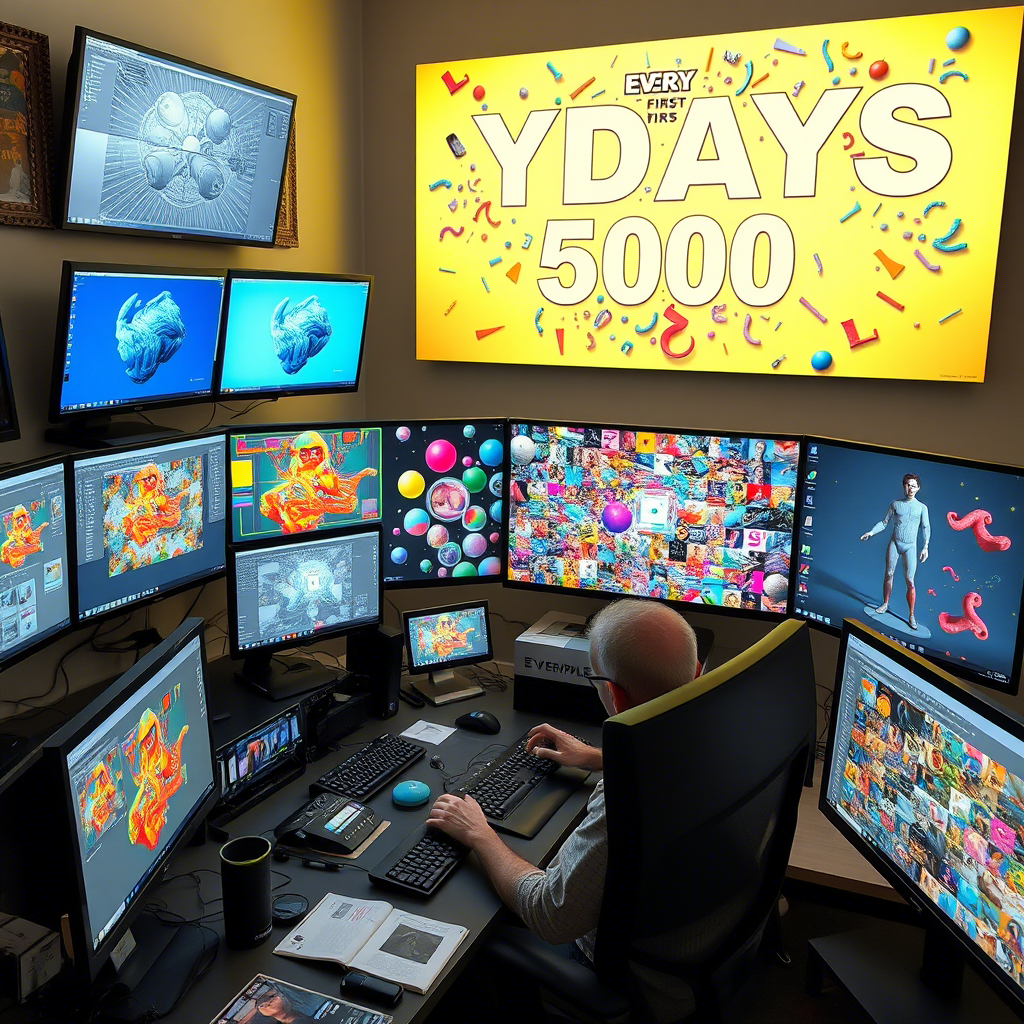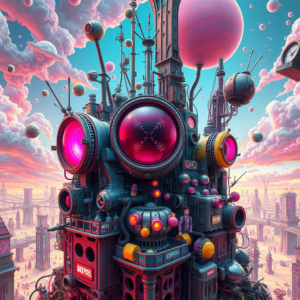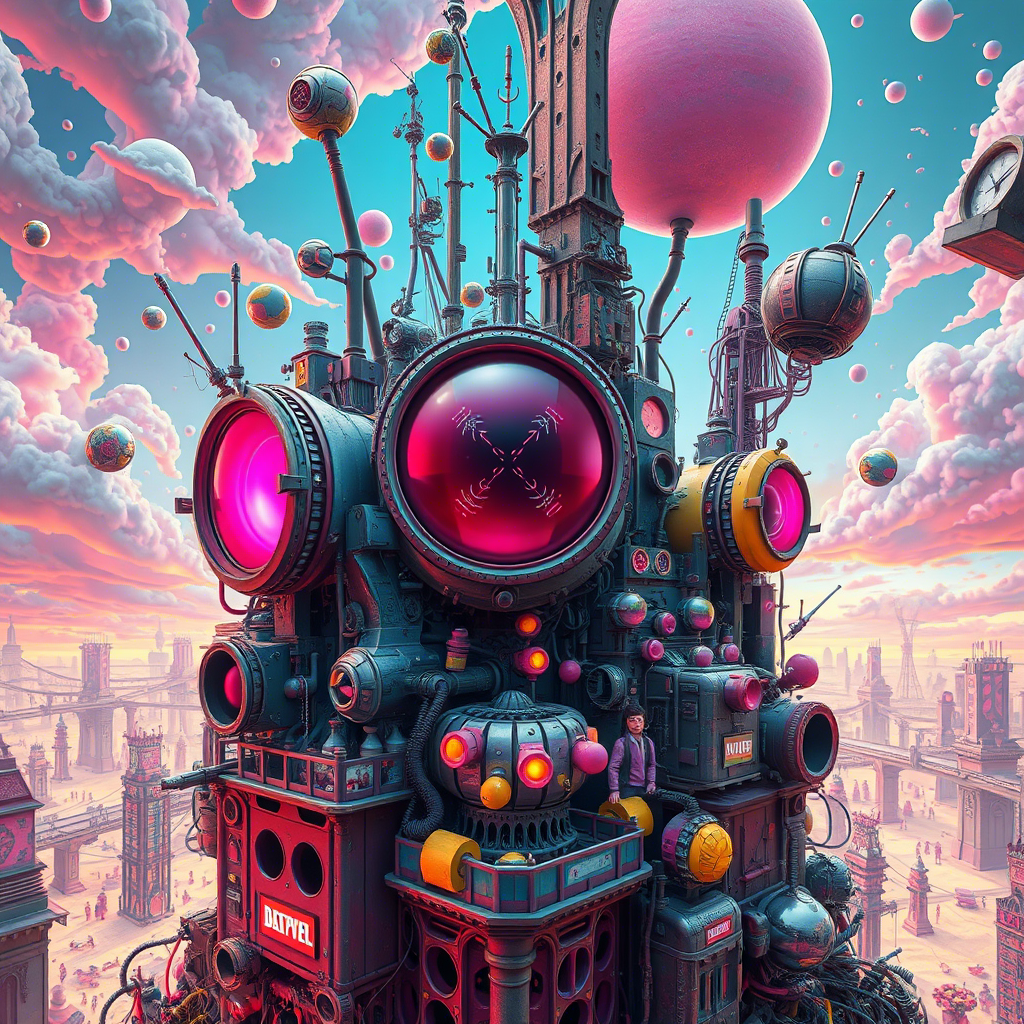
In the ever-evolving landscape of contemporary art, few names have made as explosive an impact as Mike Winkelmann, better known as Beeple. The realm of Beeple digital art has transformed the creative world, as this once-obscure creator posting daily renders online became a revolutionary figure who single-handedly legitimized digital art in the traditional art market with his record-shattering $69 million NFT sale. Beeple’s journey represents a pivotal moment in art history where digital creation finally received mainstream recognition and validation, with Beeple digital art leading this paradigm shift.
Key Points Beeple Digital Art:
- Beeple (Mike Winkelmann) created “EVERYDAYS: THE FIRST 5000 DAYS,” which sold for $69 million at Christie’s in 2021
- His “Everydays” project involved creating and posting one digital artwork daily for over 13 years
- Beeple pioneered the mainstream adoption of NFT (Non-Fungible Token) art
- His work blends dystopian themes, political commentary, pop culture, and technological critique
- Beeple’s success has fundamentally changed how digital artists can monetize their work

Who Is Beeple? The Man Behind the Digital Revolution
Mike Winkelmann began his artistic journey far from the spotlight. Born in 1981 in Wisconsin, Winkelmann graduated with a computer science degree but harbored creative aspirations. In 2007, he started what would become his defining project: creating and sharing one piece of digital art every single day. This “Everydays” project became the foundation for his eventual breakthrough.
Initially working as a graphic designer, Winkelmann developed his distinctive style while building a following online under the moniker “Beeple” or “Beeple Crap.” His early work featured 3D renderings, VJ loops for concerts, and experimental digital creations that blended surrealism with pop culture references.

“I’ve been making a picture every day for 13 years… I saw it as a way to get better at different things.
I started ‘everydays’ without knowing I would be doing it for this long.”
Mike Winkelmann (Beeple)
What separates Beeple from many digital artists is his unwavering commitment to his daily practice. Through this disciplined approach, his technical skills and artistic vision evolved dramatically over time, creating a visual diary of both his personal growth and the changing digital landscape.
The Everydays Project: A Decade of Digital Dedication
The “Everydays” project represents one of the most impressive feats of artistic consistency in recent history. Beginning on May 1, 2007, Winkelmann committed to creating and sharing one new artwork every day without fail.
Evolution of Beeple’s Artistic Style
Beeple’s early works were relatively simple, often consisting of basic 3D models or digital sketches. As his skills developed, his art evolved to incorporate
Beeple Digital Art Timeline:
Beeple: From Obscurity to Art World Sensation
Early Digital Art (Pre-2017)
Rise to Prominence (2017-2020)
Mainstream Breakthrough (2020-2021)
Post-Christie’s & Continued Work (2021-Present)
- Increasingly complex 3D modeling and rendering
- More sophisticated lighting techniques
- Narrative-driven compositions
- Political and social commentary
- Recognizable stylistic elements including dystopian landscapes, pop culture references, and technological critiques
The progression visible across his thousands of daily creations demonstrates not just technical improvement but also the development of a distinctive visual language that made his work instantly recognizable.
The Historic Christie’s Auction: When Digital Art Made History
On March 11, 2021, the art world was forever changed when Christie’s auction house sold Beeple’s “EVERYDAYS: THE FIRST 5000 DAYS” for $69.3 million. This collage, comprising 5,000 consecutive daily artworks created from 2007 to 2021, became the third most expensive artwork by a living artist ever sold at auction.
What made this sale revolutionary was not just the price, but what it represented: mainstream acceptance of digital art as a legitimate art form worthy of substantial investment.
The NFT Revolution in Art
The sale was conducted as an NFT (Non-Fungible Token), a unique digital certificate of ownership stored on blockchain technology. This auction marked a watershed moment for NFTs, bringing the concept into public consciousness and legitimizing a new way for digital artists to monetize their work.
The implications were profound:
- Digital artists suddenly had a new avenue for selling their work
- The traditional art world was forced to reckon with digital creation
- Blockchain technology demonstrated its application in establishing provenance and scarcity in digital media
- New conversations about the nature of art ownership emerged
As noted in “AI Art in 2024: The Creative Revolution at Your Fingertips”, the boundaries between traditional and digital art continue to blur, with Beeple being a major catalyst for this transformation.
Artistic Themes and Stylistic Elements in Beeple’s Work
Beeple’s artistic voice is immediately recognizable, characterized by several recurring themes and visual elements that define his unique approach to digital creation.
Political and Social Commentary
Many of Beeple’s most powerful works incorporate political figures and events, often portrayed through a satirical lens. His willingness to address controversial topics and current events gives his work a timely, sometimes provocative edge.
Dystopian Futurism
A hallmark of Beeple’s style is his creation of sprawling dystopian landscapes that comment on technology’s potential dark outcomes. These scenes often feature:
- Massive architectural structures
- Environmental devastation
- Futuristic technology gone awry
- Human figures dwarfed by overwhelming environments
Pop Culture References
Beeple frequently incorporates recognizable characters and elements from popular culture, remixing them into unexpected and often unsettling contexts. This approach creates an immediate connection with viewers while subverting familiar imagery.
Technical Approach: How Beeple Creates His Art

Beeple’s technical process combines various software tools and techniques to achieve his distinctive visual style. His primary tools include:
- Cinema 4D for 3D modeling and rendering
- Octane Render for realistic lighting
- ZBrush for detailed sculpting
- Adobe Photoshop for post-processing and compositing
What sets his workflow apart is the speed at which he must work to maintain his daily output. Rather than spending weeks or months on a single piece, Beeple has developed efficient workflows that allow him to complete complex renders within hours.
The Importance of Daily Practice
The “Everydays” project demonstrates the power of consistent practice. As explained in “Debunking the 10,000 Hour Rule”, while mastery may not require exactly 10,000 hours of practice, Beeple’s journey illustrates how dedicated daily creation leads to remarkable artistic growth.
The Impact on the Digital Art Market
Beeple’s success has transformed the landscape for digital artists. Prior to his Christie’s sale, digital artists struggled to monetize their work in ways comparable to traditional painters or sculptors. The advent of NFTs, catalyzed by high-profile sales like Beeple’s, created new opportunities.
NFT Marketplaces and Digital Art Collecting
Following Beeple’s breakthrough, numerous platforms emerged or expanded to facilitate the buying and selling of digital art as NFTs:
- OpenSea
- Nifty Gateway
- Foundation
- SuperRare
These marketplaces have democratized access to art collecting while creating new revenue streams for digital creators. As outlined in “Art Market Trends 2024: Top Artists, Movements, and Market Dynamics”, NFTs have become an established component of the contemporary art market.
Criticisms and Controversies
Despite his success, Beeple and the broader NFT movement have faced substantial criticism:
Environmental Concerns
Most NFTs operate on blockchain systems that consume significant energy, raising concerns about their environmental impact. This critique has prompted some artists and platforms to explore more sustainable alternatives.
Questions of Artistic Value
Some traditional art critics question whether digital works command values comparable to physical masterpieces, sparking debates about the nature of art in the digital age.
Market Volatility
The NFT market has experienced extreme fluctuations, leading to concerns about speculation and sustainability.
As explored in “AI Art Ethics: A Complete Guide”, digital art raises complex questions about ownership, originality, and value that continue to evolve.
Beeple’s Influence on Future Artists

Beeple’s rise represents more than just individual success; it has created a roadmap for digital creators to find recognition and financial reward. His influence can be seen in several key areas:
Democratization of Art Creation
Digital art tools continue to become more accessible, allowing more people to create sophisticated digital artwork without traditional art training.
New Business Models for Artists
Beeple demonstrated how building a community through consistent sharing and engagement can create substantial value, changing how artists approach their careers.
Blurring Boundaries Between Art Forms
The distinctions between digital art, traditional art, and commercial design continue to erode, creating new hybrid approaches to creation.
![Comparison of Beeple’s early digital work versus his recent creations, demonstrating his technical and artistic growth over more than a decade of daily practice.]
The Future of Digital Art After Beeple
The art world continues to adapt to the digital revolution that Beeple helped catalyze. Several trends suggest where this evolution might lead:
- Integration with physical art: More artists are exploring ways to bridge digital and physical art forms.
- Institutional recognition: Major museums and galleries are increasingly collecting and exhibiting digital art.
- Technological advancements: Emerging technologies like AR and VR are creating new possibilities for experiencing digital artworks.
- Sustainable practices: The industry is evolving toward more environmentally responsible approaches to digital art creation and distribution.
Conclusion: Beeple’s Lasting Legacy
Mike Winkelmann’s journey from anonymous digital creator to art world revolutionary exemplifies how persistence, innovation, and timing can converge to transform an entire field. By challenging preconceptions about digital creation and helping to establish new mechanisms for valuing and trading digital art, Beeple has fundamentally altered the art landscape.
For aspiring digital artists, Beeple’s story offers powerful lessons about the value of consistent practice, community building, and embracing technological change. As explored in “How to Build Your Art Brand: A Simple Guide for Artists”, the path to artistic recognition increasingly involves strategic use of digital platforms and innovative approaches to monetization.
Whether Beeple’s record-breaking sale represents the peak of a speculative bubble or the beginning of a new era for digital art, his impact on how we create, value, and experience art cannot be understated. As the boundaries between digital and traditional art continue to blur, Beeple’s pioneering work ensures that digital creation has secured its place in art history.



